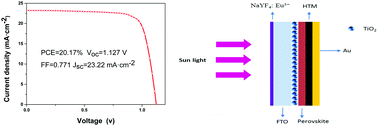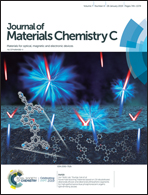Improved photovoltaic performance of perovskite solar cells by utilizing down-conversion NaYF4:Eu3+ nanophosphors
Abstract
Perovskite solar cells assembled with titanium dioxide electron transport layer exhibited brilliant photovoltaic properties due to titanium dioxide having a high electron mobility, appropriate energy level alignment and easy fabrication procedure. However, inherent instability exists in titanium dioxide-based perovskite solar cells because of the ultraviolet photocatalytic activity of titanium dioxide. This results in recombination at the interface of titanium dioxide/perovskite. In this report, the down-conversion nanocrystals film made of europium-doped sodium yttrium fluoride was deposited on the non-conducting side of the conducting glass. The down-conversion nanocrystal layer could absorb high energy ultraviolet photons and converted them to visible light. The layer not only extended the spectral response range for perovskite solar cells but also alleviated the photocatalytic activity of titanium dioxide. The perovskite solar cells with the down-conversion nanocrystals film generated average power conversion efficiency yield of 19.99%, which is much better than that of the device without the down-conversion nanocrystals film (16.99%). The best power conversion efficiency for the device with the down-conversion nanocrystals film was 20.17%. In addition, perovskite solar cells with the down-conversion nanocrystals film showed a small hysteresis.



 Please wait while we load your content...
Please wait while we load your content...